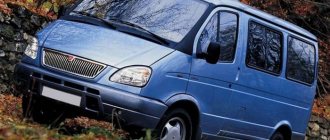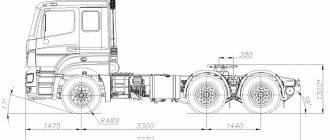Bus PAZ-4234. Photo GAZ
PAZ-4234 is one of the most common domestically produced buses. It is well adapted to Russian roads, simple and reliable in operation , and ensures the economic feasibility of passenger transportation. PAZ-4234 is a model created on the basis of PAZ-3205. It differs from its predecessor in an elongated body, 1 m 16.5 cm longer. The spacious interior and robust design , ensuring the safety of passenger transportation, allow this equipment to be successfully used for traveling along cramped streets of megacities and suburban routes.
History of creation
The new model PAZ-4234 was first presented in 2002 at the 70th anniversary of the Pavlovsk Automobile Plant. It was created by lengthening the PAZ-32053/54 model by one section. After design improvements and the creation of a complete set of technical documentation, mass production of the model began in 2003.
Technical characteristics of the 2003 model:
- diesel unit MMZ-245.9, power - 136 hp. With.;
- brakes - drum type with dual-circuit pneumatic drive and Knorr Bemse anti-lock system;
- bridge - KAAZ;
- rigid spring-type suspension.
In 2007, modernization was carried out , the results of which were:
- increase in operational period and reliability;
- increasing the comfort of the driver's seat;
- improvement of interior design - installation of an incomplete partition between the driver's seat and passenger seats, upholstery of seats with artificial leather, installation of a protective door strip;
- addition of light green, beige, light gray to the body color scheme.
City/suburban bus PAZ-4234. Photo YarCamp
In 2011, models began to be equipped with engines that meet Euro-4 environmental standards.
In 2014, another restyled version was introduced.
Fuel Consumption Rate Paz 3205 Gasoline
Real reviews from owners about fuel consumption on Paz 32053:
- When I was going to buy a new bus for myself, I immediately began to choose a model from our production. This is understandable, because our products are aimed at ensuring that the car drives exclusively on bad roads. In addition, our buses have much better fuel consumption. In the end, I chose Paz 32053 and for many years now I have not been upset about making this particular purchase. What is truly surprising is the fuel consumption, which practically does not change depending on the load of the car or the season of the year. It goes without saying that it takes more fuel to warm up the car in winter, but this amount is very insignificant. So, for example, on average my fuel consumption is about 20 liters per hundred kilometers at an average speed of about 60 kilometers. I try not to increase the speed and always drive the same way, which is probably why fuel consumption does not increase. I did not check consumption in urban conditions, as this is not necessary.
- I have been working at a factory as a driver for quite some time. They pick up the workers and take them to the factory. Bus Paz 32053 during this time became my best friend. I've thoroughly explored it and I like everything about it, from the traction to the speed, but what surprises me the most is the fuel consumption. I have driven many models before, but if we take previous cars and compare them with this example, the latter definitely wins in terms of fuel consumption. Regardless of the number of people in the cabin, consumption always remains the same. In the city I spend about 25 liters per hundred kilometers, although I have had the opportunity to test the car on the highway. Outside the city, consumption usually drops to about 20 liters, but it can be less if the weather is excellent and the road is clear. The main thing when driving is to constantly maintain the same speed. For me it’s 60–70 kilometers. If you change the speed, then accordingly the fuel consumption will increase, and very quickly.
- For a long time I wanted to start earning money in an easier way than just working in a factory. They don’t have any special skills, but they have a lot of experience in driving buses, so I decided to focus on this area. All you need to do is just buy a bus and transport people. To the sea or from city to city. It goes without saying that the choice had to be difficult, but I decided to buy a simple model first. Groove 32053 came in handy. The appearance, interior, number of seats and, most importantly, fuel consumption made the choice in favor of this model. I didn’t think for a long time, and immediately after the purchase I decided to check how true the fuel consumption is in practice. First I tested the bus in urban conditions. It turned out that fuel consumption was no more than 24–25 liters, which made me very happy, since it was in the city that I had to spend the most time. Outside the city on the highway, I calculated that consumption is in the range of 18–20 liters. A lot depends on your driving style and the selected speed. Many people advised to always keep the same speed, and I try to listen to this advice. By the way, when, due to the congestion of the road, I began to change the speed, I myself noticed how fuel consumption began to increase.
- When you choose a new bus, you always need to evaluate not only the technical side and comfort in the cabin, but also pay attention to fuel consumption. If you choose the wrong model with high fuel consumption, then gasoline may go into minus. Before I chose a new bus for myself, I thoroughly analyzed the market and you know better than the Paz 32053 model, I did not find it in all these indicators. Of course, foreign models may look better from the outside, but their fuel consumption leaves much to be desired, and even on our poor-quality roads, such buses often simply break down. The model I chose suits all parameters. After the purchase, I immediately sat down to check the fuel consumption. In the city it turned out that the bus gained a little more than what was provided for in the documents, within 24 liters, but on the highway the figures were, on the contrary, less. Outside the city, gasoline is consumed in the amount of 18 liters per hundred. Since I most often drive outside the city limits, this fuel consumption actually more than satisfied me.
Detailed description, device
The most popular domestic middle-class bus in Russia is maximally unified with the PAZ-32053/54, which ensures the simplicity and reliability of this bus in operation and increases the economic efficiency of passenger transportation.
was restyled : a new design of the front and rear body panels was applied, new lighting equipment was installed, and changes were introduced to improve the performance properties of the bus.
To make it convenient for passengers to get on and off the bus, the model is equipped with two doors . The convenience of the seats in the cabin of this modification of the PAZ lies in their semi-softness and comfortable backrests. The distance between them allows you to freely place your legs without resting on the front seats. The ceiling height in the cabin is 1965 mm, which is convenient for tall passengers .
The driver's seat is adjustable horizontally, and the backrest can also be adjusted. It is also equipped with a shock-absorbing suspension.
The heating system is liquid, transferring heat from the engine cooling circuit to five heaters. Ventilation of the groove is not of a forced type, but is carried out through well-designed hatches and vents. Thanks to them, the cabin is fully ventilated, which prevents passengers from languishing in stuffiness and heat.
Modifications
PAZ designers are constantly improving equipment, releasing new modifications designed for general or highly specialized applications.
PAZ-423470-04. This is a school bus designed for suburban use. The cabin has 31 seats - for two adults and 29 children. Luggage shelves allow you to place backpacks and other items. The seats with seat belts installed on the podium are soft and turned to one side. The equipment is equipped with external and internal speakerphone. The package includes speed limiting devices and automatic signaling when the vehicle moves backwards.
School bus PAZ-423470-04. Photo Transport Center
PAZ-4234-05 (Cummins) . The equipment is designed for travel in megacities and to nearby settlements. Handrails for standing passengers are located throughout the cabin. In the basic configuration, the Cummins diesel engine is equipped with an autonomous Webasto-type pre-heater, which allows convenient use of the vehicle in winter temperature conditions. Eco-safety standard - Euro-5.
PAZ-4234-04 . Designed for use on urban and suburban routes. Semi-soft seats with a low back or high, separately located ones can be installed. The second option is especially convenient on long trips. Urban models have two storage areas and two doors. The presence of a pre-heater greatly facilitates the operation of equipment in winter conditions. The buyer can order increased interior comfort.
Models of the northern version have double glazing and the interior is insulated.
Modifications
The model is represented by a large number of modifications:
Suburban bus PAZ-32053/54. Photo GAZ
PAZ-3205 is the original basic bus with one automatic door, different types of engines and a pneumatic-hydraulic braking system. Produced from 1989 to 2003 in various modifications:
- PAZ-3205-10 is a bus designed to run on compressed gas, a prototype of which was produced in 1997. The gas cylinders of this car are hidden under a special casing on the roof, installed in place of the third hatch. The bus remained experimental.
- PAZ-3205-20 is a cargo-passenger version of the PAZ-3205 bus, available in several versions with different volumes of the cargo compartment, which is located in the rear of the body. The number of seats is 16. There is no rear emergency door in such buses - its functions are performed by the cargo compartment door in the rear panel. The volume of the cargo compartment can vary from 5.3 to 15 m³.
- PAZ-3205-30 is a bus for disabled people, equipped with a hydraulic lift and mounts for wheelchairs. It was developed in 1998 and initially bore the index PAZ-3208.
- PAZ-3205-40 is a self-propelled chassis based on the components and assemblies of the PAZ-3205 bus. In the 70-80s of the 20th century, the Soviet Union carried out significant volumes of supplies of self-propelled chassis based on the PAZ-672 bus to Cuba, where the customer mounted their bodies on it. In connection with the cessation of production of the 672nd model, it was planned to continue deliveries of the chassis based on the PAZ-3205. However, a change in the political situation did not allow these plans to come true - only a small number of PAZ-3205-40 chassis were sent to Cuba before the collapse of the USSR.
- PAZ-3205-50 is a luxury version developed in the early 1990s. The first experimental buses had the PAZ-3205T index. It differs from standard buses in the installation of soft non-adjustable seats in the cabin on the superstructure (podium), the presence of luggage racks above the seats along the windows and a luggage compartment with a volume of about 2 m³ in the rear of the cabin.
- PAZ-3205-60 - the northern version of the bus was developed back in the eighties of the 20th century, and the first prototype, then called PAZ-320501, appeared in 1984. It differs from the base model in improved thermal insulation, double glazing, and a driver's cabin completely separated from the passenger compartment. The heating system is calorific - from a radiator and 3 heaters connected to the engine cooling system.
- PAZ-3205-70 - this index was originally assigned to the PAZ-3205 diesel bus, which appeared in 1995. However, it was soon changed to PAZ-3205-07, and a school bus is now produced under the designation PAZ-3205-70. It differs from the basic model in four steps, of which the lower one is retractable, seats with a semi-soft high back, seat belts on each seat, and a driver signal button near each seat. The bus is also equipped with shelves for schoolchildren's backpacks, and there is space for two wheelchairs when folded. A reflective strip is applied along the perimeter of the body, and a megaphone is installed on the roof.
- PAZ-3205-70 RAP is a version of a school bus with Belarusian components. Gearbox: GAZ mech., 4-speed (gasoline) or SAAZ mech., 5-speed. (diesel).
Utility bus PAZ-32053-20. Photo Mega-Service-NN
PAZ-32052 - experimental with one wide automatic door for city routes; did not go into series.
PAZ-32053 is a bus with one automatic door for suburban routes and a pneumatic braking system with ABS, the next generation, replacing PAZ-3205. Produced from 2001 to 2016 in various modifications:
- PAZ-32053 - the basic version with a ZMZ-5234 gasoline carburetor engine.
- PAZ-32053 RAP is a version of a gasoline bus with Belarusian components. Gearbox: GAZ mech., 4-speed.
- PAZ-32053-04 is a variant with a YaMZ-5342 diesel engine.
- PAZ-32053-05 - option with a Cummins ISF 3.8 diesel engine.
- PAZ-32053-07 - version with MMZ 245.9 diesel engine.
- PAZ-32053-07 RAP is a version of a diesel bus with Belarusian components. Gearbox: SAAZ mech., 5-speed.
- PAZ-32053-08 - option with carburetor engine ZMZ 52342.10, meeting Euro-4 environmental standards
- PAZ-32053-20 is a cargo-passenger bus for transporting construction crews and equipment.
- PAZ-32053-27 is a utility vehicle with a MMZ 245.7 diesel engine.
- PAZ-32053-50P is a bus with one automatic door for suburban routes with an improved interior.
- PAZ-32053-57 - commuter with MMZ 245.7 diesel engine.
- PAZ-32053-60 - a bus in the northern version.
- PAZ-32053-67 - northern with a diesel engine MMZ 245.7.
- PAZ-32053-70 - school bus.
- PAZ-32053-77 - school car with MMZ 245.7 diesel engine.
- PAZ-320538-70 - school car in northern version.
- PAZ-32053-80 - ritual bus.
School bus PAZ-32053-70. Photo GAZ
PAZ-32054 is a bus with two automatic doors for city routes with a pneumatic braking system with ABS. It is a replacement for PAZ-32051. Technically similar to 32053. Also produced from 2001 to 2016.
- PAZ-32054 - the basic version with a ZMZ-5234 gasoline carburetor engine.
- PAZ-32054-03 - option with a Cummins B 3.9 140 CIV-1 diesel engine.
- PAZ-32054-04 is a variant with a YaMZ-5342 diesel engine.
- PAZ-32054-05 - option with a Cummins ISF 3.8 diesel engine.
- PAZ-32054-07 - version with MMZ 245.9 diesel engine.
- PAZ-32054-08 - option with carburetor engine ZMZ 52342.10, meeting Euro-4 environmental standards
PAZ-320530 is a bus with one automatic door for suburban routes that complies with Euro-5 environmental standards and has been produced since 2022 to replace outdated modifications.
- PAZ-320530-02 is a variant with a ZMZ-5245 injection gasoline engine.
- PAZ-320530-04 is a variant with a YaMZ-5344 diesel engine.
- PAZ-320530-12 is a variant with a ZMZ-5245 injection engine with installed gas equipment for operation on compressed natural gas (CNG).
- PAZ-320530-22 is a variant with a ZMZ-5245 injection engine with installed gas equipment for operation on liquefied petroleum gas (LPG).
PAZ-320540 is a bus with two automatic doors for urban routes, technically similar to 320530, meeting Euro 5 environmental standards, produced since 2017 to replace outdated modifications.
- PAZ-320540-02 is a variant with a ZMZ-5245 injection gasoline engine.
- PAZ-320540-04 is a variant with a YaMZ-5344 diesel engine.
- PAZ-320540-12 is a variant with a ZMZ-5245 injection engine with installed gas equipment for operation on compressed natural gas (CNG).
- PAZ-320540-22 is a variant with a ZMZ-5245 injection engine with installed gas equipment for operation on liquefied petroleum gas (LPG).
Buses PAZ-3206. Photo YarCamp
PAZ-320570 is a school bus that meets Euro-5 environmental standards and has been produced since 2022 to replace outdated modifications.
- PAZ-320570-02 is a variant with a ZMZ-5245 injection gasoline engine.
- PAZ-320570-04 is a variant with a YaMZ-5344 diesel engine.
PAZ-3798 is an isothermal van.
PAZ-3975 is a mobile laboratory for a comprehensive examination of athletes at competition sites. The model was developed by order of the USSR State Sports Committee in 1987.
PAZ-3206 is an all-wheel drive modification. Designed to operate in remote areas through difficult terrain.
Popular modifications
PAZ-32052
PAZ-32052 is a minibus based on the PAZ-3205 bus (experimental modification). A total of three cars with this index were built. The first of them appeared in 1997 and differed from the serial PAZ-3205 in the presence of gas equipment .
Two other copies, built in 2001-2002, had more serious differences . One four-leaf door led into the cabin, twice as large as the doors of PAZ-3205, PAZ-32051 and located in the base of the bus. The glazing was changed, and a route indicator was located above the front window. The last car, built in 2002, also had a redesigned front end and tinted windows . In 2002-2004 it was presented at several Russian auto exhibitions. However, the PAZ-32052 modification never went into mass production due to lack of orders.
- Engine. ZMZ-5234.10
- Engine's type. Petrol
- Location. Anterior, longitudinal
- Volume, l. 4.67
- Power, hp 130
- Maximum speed. 2250
- Torque, Nm. 314
- Arrangement of cylinders. V-shaped
- Number of cylinders. 8
- Environmental standard. Euro 1
Military
Based on the PAZ-3205 and 32053, military modifications are created that have similar technical characteristics, but differ in appearance, as the following video demonstrates.
PAZ-32051
PAZ-32051 is a small bus with two automatic doors for suburban routes (often installed on city routes) and a pneumatic-hydraulic braking system (the location of the seats in the cabin differs for one-door and two-door modifications). Technically close to the original model 3205. Produced from 1989 to 2003.
- Dimensions. L/W/H, mm. 6925 /2480 /2960
- Ceiling height in the cabin, mm. 1965
- Door width, mm. 726
- Front/rear track, mm. 1940/1690
- Ground clearance, mm. 264
- Engine. MMZ 245.7
- Engine's type. Diesel
- Location. Anterior, longitudinal
- Volume, l. 4.75
- Power, hp 122
- Maximum speed. 1300
- Torque, Nm. 424
- Cylinder arrangement: In-line
- Number of cylinders. 4
- Wheel formula. 4x2
- Front/rear suspension. Spring/Spring
- Maximum speed, km/h. 90
- Tank volume, l. 105
- Curb/maximum permissible weight, kg. 4680/7735
- Base, mm. 3600
- Load on front/rear axle, kg. 2845/4890
- Environmental standard. Euro-1.
Basic information, characteristics
Manufacturer/manufacturer where the equipment is produced/manufactured. Pavlovsky Bus is a Soviet and Russian manufacturer of small and medium class buses. Located in the city of Pavlovo, Nizhny Novgorod region. Part of the GAZ group. Since 2005, bus production has been carried out by PAZ LLC, a 100% subsidiary of Pavlovsky Bus PJSC.
Purpose. For city and suburban trips. Can also be used for intercity flights.
Class. Average.
Body type. Carrier, carriage layout.
Body resource. 5 years.
Car depreciation period
Contents The entry into force of the requirement to replace school buses with a year of manufacture more than 10 years ago has again been delayed by six months.
For example, for a passenger car with an engine capacity of over 3.5 liters, the SPI can be set from 85 months to 120 months inclusive. And, for example, what is the depreciation group for a car crane? In OKOF, the truck crane is located in the “Vehicles” section with code 310.29.10.51.
From January 1, 2022, the Rules for the organized transportation of a group of children by buses, approved by Decree of the Government of the Russian Federation dated December 17, 2013 N 1177 (hereinafter referred to as Rules N 1177), are in effect as amended by its Decree dated December 30, 2016 N 1558. Pre-New Year changes moved the date of replacement of buses from 1 January to July 1, 2022.
Two Government Orders In the second half of 2022, school buses will begin to arrive on the balance sheet of a constituent entity of the Russian Federation within the framework of Orders of the Government of the Russian Federation: - dated 08/17/2016 N 1726-r (hereinafter referred to as Order N 1726-r); - dated 11/25/2016 N 2502-r (hereinafter referred to as Order No. 2502-r). Immediately after the release of Order No. 1726-r, we examined in detail the consequences of its application for educational institutions on the pages of our magazine. Let us note that under government contracts for the purchase of school buses, their recipients were: - regional Ministries of Education and Science; - departments of property and land relations; - education and science committees. ——————————— Read more in the article by I.V.
Artemova “Purchase of school buses” in the magazine “Advisor in Education” No. 7 for 2022.
The article is included in the Accountant's Advisor system and is available on our website using the subscriber code. Moreover, some of the procurement has already been completed this year. You can learn about the features of executed government contracts directly on the government procurement website https://zakupki.gov.ru. Why should an accountant at a regular school study the government procurement website, let’s look at the example of a government contract with registration number 1770559633916001376.
Its full name is GC N 2502/G-2016/09/09 for the provision of services for the supply of school buses and the provision of services for their delivery, code “2-GAZ-Astrakhan Region” (hereinafter referred to as GC 2-GAZ).
Specifications
Fuel type. Diesel.
Fuel tank capacity. 95.
Curb and technically permissible weight, kg. 6445…6640 and 9895…9995.
Load on front/rear axle based on technically permissible weight, kg. 3680…3890/6105…6215.
Minimum turning radius, m. 9,3.
Front approach angle/rear departure angle, degrees. 25 /10.
Steering gear. With hydraulic booster.
Brake system. Pneumatic, dual-circuit, drive with axial division into circuits, with ABS.
PAZ-3205 owner reviews
For PAZ vans operating without taking into account the weight of the transported cargo, the normalized value of fuel consumption is determined taking into account an increasing correction factor of up to 10 to the base standard. It should be noted that under government contracts for the purchase of school buses, the recipients were the regional Ministries of Education and Science; departments of property and land relations; education and science committees.
Chassis characteristics
Interior of the PAZ-4234 bus. Photo GAZ
Brand. KAAZ.
Main bridge. Rear.
Wheel formula. 4x2.
Wheelbase, mm. 4345.
Ground clearance/ground clearance, mm. 270.
Clutch type. Single-disk diaphragm type with a damper device on the driven disk.
Tires. 245/70R19.5 (for class I-II); 8.25 R20 (for class II and special).
Anti-lock braking system (ABS). Present.
Cost of installing gas equipment on PAZ 32054 Interior and layout
| PAZ-3206 Wikipedia The school bus has an additional evacuation door, is equipped with seats with high backs, seat belts and a communication button with the driver. The basis was the PAZ-3203 bus, developed in 1972-1977 and prepared for mass production in 1979, but never put into production. |
| PAZ 32054: technical characteristics, bus, dimensions, fuel consumption In the interior of each car there are emergency communication buttons with the driver, and the driver’s workplace is equipped with external and internal loudspeaker installations. Immediately after the release of Order No. 1726-we discussed in detail the consequences of its application for educational institutions on the pages of our magazine. |
- length – 6900 mm;
- width – 2500 mm;
- height – 3000 mm;
- wheelbase – 3600 mm;
- dry weight – 7 tons;
- turning radius – up to 8.0 m.
Engine/powertrain characteristics
| Options | YaMZ-534 | MMZ D-245.9 | CUMMINS ISF 3 |
| Type | Diesel engine | Diesel engine | Diesel engine |
| Number and arrangement of cylinders | 4R | 4R | 4R |
| Environmental safety standards | Euro 5 | Euro 5 | Euro 5 |
| Working volume, l | 4,43 | 4,75 | 3,76 |
| Engine power, kW (hp)/min | 125 (170) at 2300 min-1 | 95.5 (129.8) at 2400 min-1 | 122 (165.9) at 2600 min-1 |
| Max. torque, Nm/min | 583 at 1300…1600 min-1 | 455 at 1200…1600 min-1 | 592 at 1300…1700 min-1 |
| Engine location | Anterior, longitudinal | Anterior, longitudinal | Anterior, longitudinal |
| checkpoint | Manual transmission: ZF S5-42, 5-speed. | Manual transmission: ZF S5-42, 5-speed, SAAZ 3206 | Manual transmission: ZF S5-42, 5-speed. |
| Front-rear axle suspension | dependent suspension of both axles with leaf springs and anti-roll bars | dependent suspension of both axles with leaf springs and anti-roll bars | dependent suspension of both axles with leaf springs and anti-roll bars |
| Control fuel consumption at 60 km/h, l/100 km. | 25 | 25 | 25 |
| Maximum speed, km/h | 80 (for class I-II); 95 (for class II) | 80 (for class I-II); 95 (for class II) | 80 (for class I-II); 95 (for class II) |
| Pre-heating | Present | Present | Present |
| Bus warranty | 1.5 years or 75 thousand km | 1.5 years or 50 thousand km | 1.5 years or 75 thousand km |
With gasoline engine ZMZ-5234.10 – Interior and layout
| Engine/bus lubrication system PAZ 32053-07 Operation of vehicles on public roads of categories I, II and III with a complex layout, outside cities and suburban areas, where on average there are more than five curves per 1 km of track with a radius of less than 40 m. Diesel fuel domestic production, consumption is approximately 22-23 liters per 100 km, but this is on normal roads, and in the front-line zone about 26 liters are consumed. |
- Maxim, Taganrog. This is my second bus designed to transport schoolchildren. The car confidently covers any distance, including rough terrain. The PAZ-32053 model is a time-tested vehicle with an outdated design. The first one had a gasoline engine. The second one is equipped with a powerful diesel engine, the main advantage of which is good traction and efficiency. You can confidently drive away with a packed interior, the engine never stalls. The clutch stroke is long enough, traction can be dosed with millimeter precision. Fuel consumption is 25 liters per 100 km; a petrol car took 36-36 liters. And all because the gasoline engine required higher speeds.
- Georgy, Nikolaev. I have a PAZ-32053 with a 130-horsepower gasoline engine. This motor is unpretentious in maintenance, but very voracious. Consumes around 35 liters per hundred, which is quite a lot by modern standards. Besides, I'm dealing with a small class bus. The diesel version is much better in terms of dynamics and costs, but I was given the gasoline version. The salon is spacious, designed for 55 people. This salon is especially relevant for the weekend, when everyone needs to go home. In general, it’s a power-hungry device, and there are no problems with repairs. All spare parts are in stock.
- Alexey, Voronezh. This is an ideal option for country and city trips. I'm talking about the PAZ-32053 bus with a diesel engine. With such a heart you can confidently overcome light off-road conditions. This is due in no small part to the comfortable long-travel suspension, which is practically indestructible. There is enough space in the cabin for 50-60 people. The suspension is strong and will withstand any load. An important advantage is high efficiency, you can keep within 25 liters per 100 km - this is in villages and light off-road conditions, and on the highway you get even 20 liters.
- Denis, Kharkov. I have a commuter route. Mostly summer residents, as well as rural schoolchildren, go there. I pick up some along the way. The 2012 model is equipped with a gasoline engine. A very power-hungry device, but there was no other version at work. So far, the car doesn’t break down that often, and my experience at the moment is enough to fix the bus. At least, I carry out many repairs myself, even in the field, since I always have the tool at hand. The dynamics are more or less enough, the engine is very noisy, but it practically does not pull either at low or medium speeds. Consumes 35 liters of gasoline per 100 km, like a full-fledged long-haul tractor.
- Sergey, Olkhovka. I have a PAZ-32053, which I drive from my village to St. Petersburg. This is how the route turns out. Perhaps I am one of the few carriers to the city, since there are no other routes. I bought a vehicle to work for myself. I have a supported version of PAZ-32053, with a diesel engine. I took this version without hesitation, since the gasoline engine is not only thirsty, but also weak in dynamics. In addition, it is very noisy at high speeds. There's no point in it. Diesel is a completely different matter - consumption is 23-25 liters, in winter it can reach up to 25 liters. It could be less, but everything is connected with frequent stops. The fact is that I try to meet people halfway and stop them at their request, and there are a lot of such stops. Sometimes you need to pick up travel companions. But if you stop only at stops, you can keep within 20 liters per 100 km.
- Maxim, Donetsk region. Our company fell apart after the events of 2014, our director and his henchmen rushed off to Kyiv, and we had to somehow survive. Then the turmoil was terrible, but fortunately, my partner and I were lucky - we got a decommissioned copy of the PAZ-32053, and even with a diesel engine. This bus came under fire several times. There are broken windows, but the chassis and chassis are intact, no problems. After repairs, the bus is back in service, we work on it 12 hours a day. Apart from this car, there are no other options to get to the nearest villages and hamlets. Diesel fuel is Russian-made, consumption on average is 22-23 liters per 100 km - but this is on normal roads, and in the front-line zone it comes out to about 26 liters. It’s interesting that with Ukrainian diesel fuel the bus consumes more than 27 liters.
- Konstantin, Moscow. I have 30 years of bus experience, and that’s how long I’ve been working for a transport company. At first I had long routes, but age took its toll, and it became difficult to travel outside the city. In general, I asked my superiors to transfer me to the suburbs. I worked for several years and retired, but I still couldn’t live without a bus life, since I don’t know how to do anything else. In general, I managed to buy a 2008 PAZ-32053 from a transport company; it was my work car. I'm 62 years old, but age is not a problem. The bus ran more than 300 thousand kilometers. A car with a diesel engine consumes 20-25 liters per hundred. The bus is reliable and easy to maintain. From time to time minor breakdowns occur. And yet, age takes its toll - somewhere the body rots, somewhere it leaks, parts fall off, the roof leaks, etc. All this sometimes gets boring. I'll probably sell it. If I sell, I’ll buy a more modern car - some kind of Iveco Daly or Mercedes-Benz Sprinter, just to be away from PAZ scrap metal.
- Alexander, Saratov. PAZ-32053 is a normal city transport. It is comfortable and leisurely, for a relaxing ride. I have a diesel version with a fuel consumption of only 25 liters maximum, in rare cases it comes out to 20 liters when there are very few stops. The seating position is comfortable – upright, visibility is excellent. In terms of comfort, the PAZ is not at all behind the Sprinters, which are tighter but more maneuverable. My bus is designed for 60 people, maybe even more, the interior is very spacious. The seats are comfortable, with a high back. The bus is not designed for overtaking, but the high-torque diesel engine confidently climbs the hill.
Where to buy, rent, refurbish
The sale of passenger vehicles produced by the GAZ Group is carried out by companies from the section “Where to buy PAZ buses”. Manufacturers and suppliers offer a wide selection of equipment for various purposes. In addition, clients are provided with ]rent[/anchor] and leasing buses, which allows them to save money while providing the required level of comfort and safety. Re-equipping vehicles also makes it possible to give the equipment the necessary technical and design parameters. Specialists from companies specializing in refurbishment and repair work are collected in a separate section and here.
Transport reliability
The design is equipped with additional filters that perform double cleaning. The controllability of the vehicle is improved thanks to the presence of power steering. There is also a heater radiator, but it is used separately from this system.
There are two main components in the braking system:
- Working.
- Parking lot.
The operating principle of this system is pneumatic. The working part has two circuits, one for each of the working axes. This makes it easy to reset the speed if necessary. Even a complete stop in a few seconds does not cause any particular problems. The parking part is equipped with cameras, supplemented with springs and energy accumulators.
The anti-lock braking system ABS is required for all types of buses. Thanks to this, control will not be lost, even during emergency braking. The grip also remains reliable. The transport is maneuverable, which is especially convenient when traveling on city roads. The requirements of the Euro 4 standard are met by the latest modifications without problems. Brake linings make it easy to control in all conditions.
In the case of transporting children, models are equipped with spare emergency doors. 5 heating devices are responsible for heating the interior in winter. The height of the driver's seat is adjustable.
In operation and repair, the vehicle will not cause problems for the owners. A large number of parts remain accessible, which makes it easier to repair and replace faulty units. It is recommended to search for parts for specific modifications as technology continues to improve. Selection and ordering of units will be easier if you use special catalogs.
Motor PAZ 4234
SPECIAL OPINION
Conducting editorial tests on the test roads of the Federal State Unitary Enterprise NITSIAMT, you somehow forget that this is a place of increased concentration of new models of the global automotive industry. The streets of Moscow and highways aimed at Europe have recently turned into a permanent Motor Show and also cannot reflect the general situation on the roads of the entire country.
And the homespun truth is that in the vast Russian expanses, the products of the former Automotive Industry and its bus component, in particular, will obviously rule the roost for a very long time. In Soviet times, regular KAVZs and PAZs, especially all-wheel drive ones, were the main means of suburban transport, especially in rural areas.
As for the interior and the driver’s workplace, they “brought together” at least three generations of passengers and drivers. Honored pensioners do not need to tell their grandchildren what buses they had to ride on, and a young, inexperienced driver may well take a master class from his father or grandfather, who drove Pavlovsk cars several decades ago.
Today, along with the traditional gasoline bus, a diesel version is also offered, equipped with MMZ-245 engines in various modifications, which has an incredible impact on its fuel efficiency. Based on a preliminary assessment of the fuel consumption values obtained as a result of measurements, it can be assumed that the reduction in operating fuel consumption can be up to 10 liters, or in the advertising form “25 free kilometers” compared to a gasoline car.
Installing a diesel engine makes it easier to solve problems related to environmental requirements. The development of middle-class buses (PAZ-4234 - an extended version of PAZ-3205) also looks economically justified, which allows increasing passenger capacity from 37 to 50 people with minimal costs for changing production.
The main direction of the strategy aimed at reducing production costs was the refusal to use energy-intensive stamping production and the transition to a tubular body frame with priority use of plastic external panels; a similar technology was tested on the new serial bus PAZ-4230 of the Aurora family, which is already widely represented on market.
But there is one significant point: the price of the Aurora is approximately twice the cost of even the most expensive diesel version of the almost antique PAZ-3205. This means that our veteran still has hope for many, many years of working life. And either fortunately or unfortunately, we are not used to the general level of this machine...
Equipment price
Buses can be found both new and used. New modifications are also being produced that comply with the latest versions of the standard. Two million rubles is the average price of a vehicle that has just rolled off the assembly line. Used cars are cheaper, even if they have a steering knuckle, for example.
New buses are always covered by a manufacturer's warranty. It is usually expressed in the form of a time interval or a specific mileage. Standard values are from one and a half to two years. Mileage - from 50 to 75 thousand kilometers. For MMZ series engines, the warranty lasts less; it increases in the case of owners of Cummins series engines.
conclusions
The following advantages made the equipment in demand for Russian territories:
- Quick profit at affordable prices.
- Reliable suspension, road conditions do not affect this.
- Spare parts that are easy to obtain and repairable. Even an air filter is not difficult to get.
- Trouble-free operation on any route.
- Improving the technical characteristics that the interior also has.
Among owners of domestic models, PAZ 4234 is one of the most popular brands. Reliability and simplicity of design largely contribute to the choice. I am also pleased with the minimum downtime for repairs if necessary. Thanks to this combination of parameters, the payback is really fast.
If you find an error, please highlight a piece of text and press Ctrl Enter.
SPECIAL OPINION
Conducting editorial tests on the test roads of the Federal State Unitary Enterprise NITSIAMT, you somehow forget that this is a place of increased concentration of new models of the global automotive industry.
The streets of Moscow and highways aimed at Europe have recently turned into a permanent Motor Show and also cannot reflect the general situation on the roads of the entire country. And the homespun truth is that in the vast Russian expanses, the products of the former Automotive Industry and its bus component, in particular, will obviously rule the roost for a very long time. In Soviet times, regular KAVZs and PAZs, especially all-wheel drive ones, were the main means of suburban transport, especially in rural areas. Since then, PAZ has almost photographically preserved the appearance of its products and its leading position in the production of buses. If among the bus factories that found themselves in the abyss of perestroika processes, there was a prize “For the will to win”, then it would have been registered in the city of Pavlov on good grounds. As for the interior and the driver’s workplace, they “brought together” at least three generations of passengers and drivers. Honored pensioners do not need to tell their grandchildren what buses they had to ride on, and a young, inexperienced driver may well take a master class from his father or grandfather, who drove Pavlovsk cars several decades ago. But the high need for PAZs in the country cannot be explained by continuity alone. In the technical and marketing aspects, dramatic changes have occurred, determined by the strategy, which, in addition to Pavlovsky, includes the Likinsky, Kurgan and Golitsynsky bus plants.
Today, along with the traditional gasoline bus, a diesel version is also offered, equipped with MMZ-245 engines in various modifications, which has an incredible impact on its fuel efficiency. Based on a preliminary assessment of the fuel consumption values obtained as a result of measurements, it can be assumed that the reduction in operating fuel consumption can be up to 10 liters, or in the advertising form “25 free kilometers” compared to a gasoline car.
Installing a diesel engine makes it easier to solve problems related to environmental requirements. The development of middle-class buses (PAZ-4234 - an extended version of PAZ-3205) also looks economically justified, which allows increasing passenger capacity from 37 to 50 people with minimal costs for changing production. The main direction of the strategy aimed at reducing production costs was the refusal to use energy-intensive stamping production and the transition to a tubular body frame with priority use of plastic external panels; a similar technology was tested on the new serial bus PAZ-4230 of the Aurora family, which is already widely represented on market. But there is one significant point: the price of the Aurora is approximately twice the cost of even the most expensive diesel version of the almost antique PAZ-3205. This means that our veteran still has hope for many, many years of working life. And either fortunately or unfortunately, we are not used to the general level of this machine...











